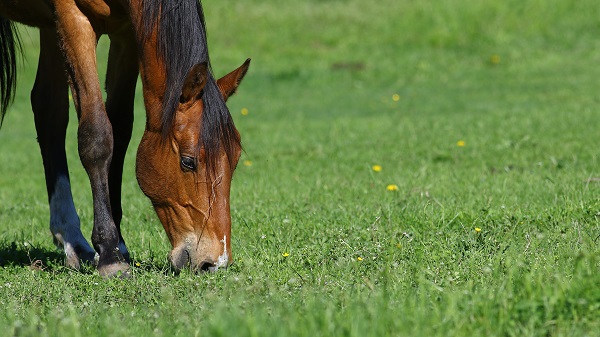Posted: 14th March 2019 | Back to news feed

Winter sees most domesticated horses in the Northern Hemisphere being fed dried forage for months on end to make up for the poor (or, in some cases, non-existent grass) in their field during the cold, dark months. But, once the weather starts to warm up and the days lengthen, grass growth can suddenly go mad with the arrival of spring grass. Even though it looks hugely appealing, and historically spring grass was referred to as ‘Dr Green’ for the therapeutic effect it was thought to have on equines, it can present a problem for horse owners. Horse health company Haygain takes a look at why spring grass can be disruptive for both a horse’s digestive system and its metabolism, and what owners can do to mitigate the risks.

Why is spring grass dangerous for horses?
Spring grass is high in a type of sugar called fructan, which is present as a by-product of photosynthesis and is used to fuel plant growth. Fructans are non-structural carbohydrates (NSCs) that horses can’t digest, and they boost the energy content of grass enormously. If a horse has been fed dried forage for months on end, the sudden introduction of large amounts NSCs in the horse’s gut can disturb the balance of natural bacteria and release a wave of bacterial toxins called endotoxins. These changes can trigger laminitis in horses, particularly if they are predisposed to the condition due to obesity or suffering from Equine Metabolic Syndrome. The disturbance of the gut bacteria can also trigger colic in horses who are not used to rich, sugary grass.
Is it true that spring grass is most dangerous on frosty mornings?
It is - photosynthesis requires light and therefore occurs only during daylight hours, producing non-structural carbohydrates which are then used by the plant during the night time to fuel growth. If the temperature drops below zero during the night after a sunny day, the plant will not be able to utilise the abundance of NSCs it produced during daylight hours, and they will still be present in high concentrations the next morning.
How can you manage a horse’s intake of NSCs?
- Introduce spring turnout gradually and carefully monitor your horse’s weight and condition for sudden changes.
- If you are limiting turnout to just a few hours, do it early in the morning when fructan levels should be at their lowest (apart from on frosty mornings, as per the point above). On normal, non-frosty days fructan levels will be highest in late afternoon and early evening, so avoid turnout then. Be warned, some equines get savvy to the fact they will only be out for a limited time, stick their heads down and eat incredible amounts of grass in just a few hours!
- Top (cut or mow) your turnout fields so that the spring grass doesn’t grow taller than 6 inches. This helps prevent horses from taking extra-big mouthfuls of grass with each bite.
- You could consider a grazing muzzle, but these have been shown to cause uneven tooth wear so may not be the best option for prolonged periods of grazing.
- Rotate turnout between different fields if you can. It may seem a little odd, but the grass in overgrazed fields can actually be the most dangerous of all, as it is growing quickly to prevent it being wiped out and thus is repeatedly producing young grasses which contain fructans at a higher concentration.
- When horses are stabled, feed hay that has been soaked for at least nine hours and then steamed for one hour to ensure the overall diet is low in NSCs. Soaking hay lowers the NSCs in hay and steaming it afterwards in a Haygain Steamer ensures it is free from bacteria and pathogens that can multiply so quickly when hay is immersed in water.
- If obesity is an issue for your equine then consider using a slow feeder to ensure their allocated forage takes them as long as possible to eat, therefore preventing them from being without forage for any length of time.
When is it safe to let horses graze normally again?
As we move into summer the grass will start to mature and you will see it grow more long thin stems and fewer lush, thick green leaves. This is a sign that that initial mad growth period is coming to an end, and the grass NCS content is returning to normal levels. It is worth staying vigilant to any changes in your horse’s weight and condition, particularly if you know they are prone to laminitis and obesity.
For more information go to https://haygain.co.uk/
The Equestrian Index newsfeed is compiled from articles submitted by advertising members and expresses the opinions of those members. Watsons Directories Ltd shall not be held liable for any inaccuracies or mis-statements therein.